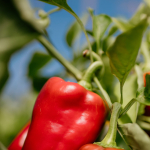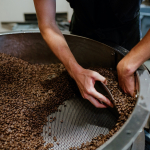40 Years of Thinking Like an Insect

Bob McCoubrey
Gary Judd is passionate about his work. As a researcher in tree fruit entomology at Agriculture Canada’s Summerland Research Station, he works hard at balancing his passion for doing the research with his enthusiasm for sharing his knowledge with growers—particularly organic growers, many of whom he has come to regard as good friends. Over his four decade career he has proven to be a true friend of organic agriculture.
Born in England and raised in South Surrey, BC, Gary had many interests as a child, and was headed for a career in marine biology, when a couple of Simon Fraser University courses in entomology, taken to fill out his timetable, drew him into the realm of insects.
Career Metamorphosis
Once bitten, Gary was hooked. He worked as an assistant to Dr. John Borden, which led to enrolling in the Masters in Pest Management program at SFU. That led to work with Bob Vernon’s pest management company, consulting with vegetable growers in the Fraser Valley. When Bob went off to pursue a Doctorate, Gary bought the company, which he ran for three years, before pursuing his own doctorate degree.
Following the conventional wisdom that postgraduate degrees should be from different universities, Gary, now married to Linda and with a new baby in tow, headed to England to study at Imperial College. He was soon back at SFU wanting to complete his degree under Dr. Borden, the man he describes as the foremost Canadian authority in chemical ecology, the study of chemicals involved in the interactions of living organisms, particularly the production and response to signaling molecules. When he defended his thesis on the Behavioural and Chemical Ecology of Onion Flies, the external advisor on his committee, Dr. Ron Prokopy, set the tone for his career when he asked Gary if he was ready to start thinking like an insect.
As he entered the doctoral program, the federal government was offering to put promising doctoral students on the payroll, with the understanding that graduates would work for Agriculture Canada once their degrees were completed. So, with a PhD in hand, and a new way of thinking in mind, the Judds were off to Harrow, Ontario in 1986, where Gary conducted research in the field of vegetable entomology for three years before securing a position at Summerland in Tree Fruit entomology in 1989.
Always one to recognize the contribution of colleagues, Gary credits some of his success to the technicians he has worked with at the research station, particularly Don Thomson, who was on the job when he arrived, and Mark Gardiner, who took over when Thomson left to work for Pacific Biocontrol Corporation. Gardiner is still helping with the important research Gary performs.
The Apple of His Eye
Early on, Thomson introduced Gary to Similkameen Valley organic growers who were struggling to control codling moth (the proverbial worm in the apple) in preparation for the Sterile Insect Release (SIR) program, which was preparing to implement Sterile Insect Technology (SIT) whereby high numbers of sterilized codling moths would be released in apple and pear orchards to reduce the opportunities for successful mating, leading to lower and lower populations as the years went by.
The theory behind Sterile Insect Technology held that a ratio of 40 sterile male moths for every wild, fertile male moth would eradicate codling moth in the orchards. As the program evolved, it became clear that the goal of eradication would have to be scaled back to one of economic control.
The success of the release program depended on starting with the lowest possible moth population levels when the first sterile moths were released. Without conventional pesticides, the tools that organic growers used to achieve low levels were limited to the removal and destruction of damaged fruit and the banding of trees with corrugated cardboard bands to trap the larval stage of the moth as they searched for a protected place in which to pupate.
Gary thought that Mating Disruption Technology (MD) would be a useful tool for both organic and conventional farmers. The technique uses synthetic versions of pheromones, the chemicals that female insects emit to attract males for mating. Codling moth pheromone had been identified in 1971, and had been successfully used in monitoring to lure males into a sticky material in a cardboard trap so they could be counted. Research had determined economic thresholds upon which control strategy decisions were based—choice and timing of chemicals.

Beginning in 1989, Gary researched pheromone dispenser design, concentration and application rates, and orchard placement of dispensers to determine the role that mating disruption could play both in reducing populations prior to Sterile Insect Release, and as a stand alone codling moth control strategy. A five year study in John Hutchinson’s Cawston orchard, using mating disruption, banding, and hand thinning, drove damage levels down from 25% to 1% at harvest time, and reduced larvae counts in the cardboard bands from 1000 per hectare to 1 per hectare. By 1994, many organic orchards had lower population pressure than conventional farms, which had been using synthetic pesticides to tackle the problem.
Because the monitoring of insect populations is essential for effective decisions on control strategies, work was done to find ways to gain accurate information from pheromone traps in orchards where Mating Disruption applications had permeated the tree canopy with the same pheromone. As sometimes happens in science, a serendipitous error in mixing pheromone doses in trap lures revealed that a dose rate 10 times the normal rate would be effective under Mating Disruption conditions. Gary credits Don Thomson with the observational skills that found the solution.
Gary’s work on Mating Disruption led him to champion the technology as a stand alone strategy for codling moth. However, the political leaders of the British Columbia tree fruit industry, and the SIR Board, made up of municipal representatives of the Regional Districts that were collecting and contributing tax revenues to fund the program, decided to proceed with Sterile Insect Release.
As sterile moths began to be released, organic growers needed to learn how SIT and MD could work together, since they lacked the synthetic pesticides that conventional growers were using to try to keep moth populations low enough for SIT to work. From ’95 to 2000, Gary’s work compared three control strategies: SIT alone, SIT with the synthetic chemical Guthion, and SIT with Mating Disruption. His research benefited from the data he had collected in organic orchards prior to the release of sterile moths, and showed the best results from a combination of SIT and MD.
With the SIR program well under way, Gary shifted his focus to secondary pests, which scientists suspected would become significant when heavy duty chemical controls for codling moth were replaced by SIT. Bud Moth and Leafroller were two such secondary pests for which Mating Disruption held promise as a control strategy, since all three species, members of the Lepidoptera order of insects, employ pheromones to help male moths find their mating partners. Dual and triple lures were tested, proving that all three pests could be controlled with the application of a single lure containing three distinct pheromones without affecting the efficacy of the strategy.
An Organic Perspective
Throughout his career, Gary has preferred to work in organic orchards. From a scientific perspective, the absence of conventional chemical pesticides eliminates one of the factors that can alter and confuse results in research conducted in conventional orchards. On a personal level, he prefers not to be exposed to toxic chemicals while doing the research, and he finds organic growers to be great people to work with, enjoying their company and their ways of approaching the work they do.
As retirement approaches in a few years, Gary is looking forward to travelling, doing a bit of fishing, driving the ‘65 Austin Healy he restored a few years back, and most importantly spending time with family—he and Linda, married for 36 years now, have four children and three grandchildren. But he plans to stay in the Okanagan, and to stay involved in the industry, doing some consulting and helping with a start-up pheromone company that will use wireless aerosol delivery of pheromones for mating disruption control strategies. His travel plans will include sharing his knowledge and skills around the world where it might be useful.
In the meantime, there are filing cabinets full of research that needs to be written up, and there are new challenges that keep emerging. Invasive species that continue to surface will need attention.
The Future of Fruit Tree Pest Management
Apple Clear Wing Moth is emerging as the most important pest in organic apple orchards. First identified in the Okanagan Valley in 2005, it is difficult for organic growers to control, as its larval stage can spend two years buried under the bark of the tree, eating the cambium layer and hiding from control measures. Gary is working on a mass trapping strategy that will use ower and fruit odours to trap out the females, combined with pheromones to disrupt mating.
Another recent arrival is the Brown Marmorated Stink bug, a pest of apples that will also attack soft fruits and vegetables. There seem to be no end of challenges to last till Gary’s retirement. His message to anyone interested in entomology: there is opportunity for a fascinating career, exploring the life cycles and habits of a wide range of species, and devising ways for humans to control the impact of those that cross swords with us.
His advice—just develop the skill of thinking like an insect.
For a person who has spent four decades in the world of creatures that most of us tend to ignore until they get in our way, Gary Judd has had an impact on the lives of organic and conventional farmers throughout agriculture in the Okanagan Valley and beyond, with contributions that are impossible to ignore. He has earned a sincere debt of gratitude.
Bob McCoubrey is a retired organic orchardist in the Okanagan’s Lake Country. With his wife Sharon, he farmed eight acres for 38 years before turning his efforts to mentorship, writing, volunteering, and community building.




